Greek Homosexuality
Homosexuality: sexual attraction to persons of the same sex. In ancient Greece, this was a normal practice.
Introduction
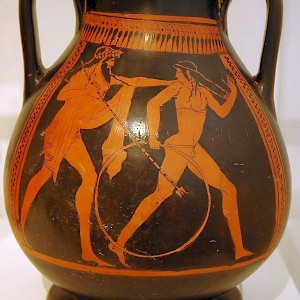
Violent debate, enthusiastic writings, shamefaced silence, flights of fantasy: few aspects of ancient society are so hotly contested as Greek pederasty, or - as we shall see below - homosexuality. Since the British classicist K.J. Dover published his influential book Greek Homosexuality in 1978, an avalanche of new studies has appeared. We can discern two approaches:
- The historical approach: scholars are looking for the (hypothetical) roots of pederasty in very ancient initiation rites and try to reconstruct a development. Usually, a lot of fantasy is required, because our sources do not often refer to these ancient rites.
- The synchronistic approach: scholars concentrate upon homosexuality in fifth and fourth-century Athens, where it was integral part of social life.
In the present article, we will use the second approach, although we won't ignore the first one. There are many sources of evidence: lyrical poetry, vases, statues, myths, philosophical treatises, speeches, inscriptions, medical texts, tragedies, comedies, curses (example), and anecdotes in which homosexual practices are mentioned, lauded, ignored, and sometimes discouraged.
The often outspoken poems and the philosophy of Plato (427-347) have resulted in our expression "Greek principles" to describe male homosexuality. Unfortunately, we know hardly anything about female homosexuality. Of course, this does not mean that it did not exist (cf. the lyrical poetess Sappho), but we simply don't know much about lesbianism. Therefore, in this article, we will have to focus on male homosexuality.
Let's start with the word "homosexual". It looks like an ancient Greek expression, but word and concept are modern inventions: the expression was coined in 1869 by the Hungarian physician Karoly Maria Benkert (1824-1882). It took several decades for the word to become current. In ancient Greece, there never was a word to describe homosexual practices: they were simply part of aphrodisia, love, which included men and women alike.
The French social critic and philosopher Michel Foucault (1926-1984) has asked whether our modern concept, which presupposes a psychological quality or a proclivity/identity, can be used to describe the situation in ancient Athens. Foucault's often-quoted answer is in the negative, because he assumes that the early nineteenth century was a discontinuity with the preceding history. And it is true: the Jewish and Christian attitudes and obsessions have never played a role in the sexual lives of the ancient Greeks. In their eyes, it was not despicable when a married man had affairs with boys, although the Athenians expected a man to have children -especially sons- with his lawful wife. The Athenian man was, according to Foucault, a macho, a penetrator, the one who forced others to do what he wanted them to do.
This view now seems outdated. Not all Athenian women have been passive and not all men were dominant. Prostitution, which was an important aspect of Athenian life, had little to do with male dominance; nor was - and this is important - Greek homosexuality restricted to pederasty between a dominant adult and a shy boy.
Pedagogical pederasty
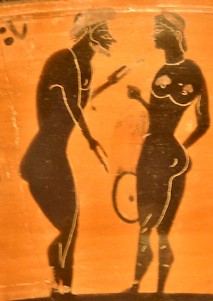
Those scholars who prefer the historical approach are convinced that pederasty originates in Dorian initiation rites. The Dorians were the last tribe to migrate to Greece, and they are usually described as real he-men with a very masculine culture. According to the proponents of this theory, pederasty came to being on the Dorian island Crete, where grown-up men used to kidnap (consenting) adolescents. It is assumed that this practice spread from Crete to the Greek mainland. In the soldiers' city Sparta, it was not uncommon when a warrior took care of a younger recruit and stood next to him on the battlefield, where the two bravely protected each other. Especially in aristocratic circles, pederasty is believed to have been common.
There are, indeed, a great many pictures on vases that show how an older lover, the erastes, courts a boy, the eromenos. They appear not to be of the same age: the erastes has a beard and plays an active role, whereas the adolescent has no beard and remains passive. He will never take an initiative, looks shy, and is never shown as excited. It is assumed by many modern scholars that as soon as the adolescent had a beard, the love affair had to be finished. He had to find an eromenos of his own.
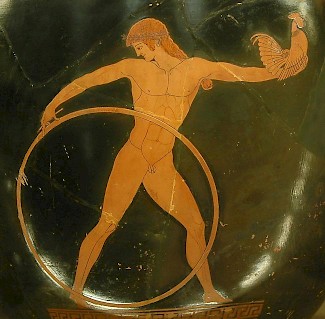
It was certainly shameful when a man with a beard remained the passive partner (pathikos) and it was even worse when a man allowed himself to be penetrated by another grown-up man. The Greeks even had a pejorative expression for these people, whom were called kinaidoi. They were the targets of ridicule by the other citizens, especially comedy writers. For example, Aristophanes (c.445-c.380) shows them dressed like women, with a bra, a wig and a gown, and calls them euryprôktoi, "wide arses". In this scholarly reconstruction of ancient sexual behavior, the older lover is presented as some sort of substitute father: he is there to help his beloved one on his way to manhood and maturity, and to initiate him in the customs of grown-up people. He showed his affection with little presents, like animals (a hare or cock), but also pieces of meat, a disk, a bottle of oil, a garland, a toy, or money. This type of love affair was, according to this modern theory, based upon (sexual) reciprocity.
Recent ideas
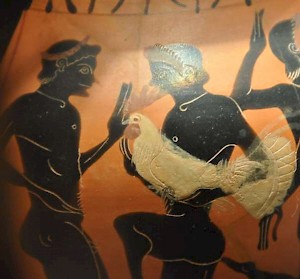
Meanwhile, however, this image of "pedagogical pederasty" has been challenged by a series of important publications like Charles Hupperts' thesis Eros Dikaios (2000). It is now clear that homosexuality was not restricted to pederasty, and that we have to study our evidence more carefully.
For example, not every older erastes had a beard, and it turns out to be a modern fairy tale that the younger eromenos was never aroused. From literary sources, we know that boys had their own sexual feelings. The sixth-century Athenian poet Theognis, for example, complains about his lover's fickleness and promiscuity. Several vases show young men with an erect penis. Even when he pretends to shy away, he does not protest and does not obstruct his lover's attempt to court him.
Another objection to the traditional reconstruction of Athenian homosexuality is that there is simply no evidence that the presents shown on vases had any pedagogic or didactic value. They are just meant to seduce.
It also appears that the difference in age did not really matter. Not youth, but beauty was important. (The ancient ideal of male beauty: broad shoulders, large chest, muscles, a wasp's waist, protruding buttocks, big thighs, long calfs. A man's forehead was not supposed to be too high, the nose had to be straight, and he had to have a projecting lower lip, a round chin, hawk eyes, and hair like a lion. His genitals had to be small; men with big penises looked like monkeys.)
There are several pictures of boys courting boys, boys playing sexual games, and adult men having intercourse. Yet, the latter was probably unusual or not spoken about, because the passive partner (pathikos) was -as we have already seen- subject to ridicule.
It is not true that homosexual love for boys was an aristocratic phenomenon. The repertory of vase paintings does not change when, in 507 BCE, democracy was introduced in Athens. On the contrary, there appears to be an increase of pederastic and other homosexual representations.
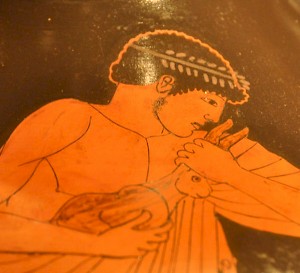
We find many pictures of schools for martial arts, which often had a statue of the god Eros and where people exercised undressed. They were considered to be a fine place to meet one's lover. There was a law that prohibited grown-up men to stay near the dressing rooms, but if the behavior of the philosopher Socrates (469-399) is typical, this law was ignored. In fact, it seems that much of Athenian love life took place in public places: many vases show how people are looking when two people are having intercourse. There is, prior to Plato, not a single written statement that people objected to public sex. (Although it is possible that the vases are just as unrealistic as modern pornography - but see below.)
The schools for martial arts were not the only places to pick up a lover. There were brothels and casinos or kybeia. The port of Piraeus and the cemeteries outside the city seem to have been popular "cruising areas" as well, and the border between ordinary love and prostitution was arbitrary. (The difference is, of course, payment, but coins were a recent invention and in the early fifth century, attitudes towards money still had to develop.) Citizen boys often received money -as payment or as present?- which might cause some problems if they embarked upon a political career. But not everyone had this ambition or the possibility to play a decisive role in the People's Assembly.
Yet, a decent citizen was supposed not to sell his body, and in c.450 BCE, when the Athenian economy had become fully monetarized, a law was proposed that people who had once prostituted themselves could not run for an office. Someone who had once sold himself was believed to be capable of selling the interests of the community as well. From now on, we find no vase paintings on which the erastes offers money to an eromenos anymore, which shows that these paintings are more or less realistic representations of what actually happened.
Later, this law was no longer applied. In the fourth century, it was not uncommon when two grown-up men shared a home. There must have been jokes about these men, but obviously, they found this an acceptable price to pay for living with their beloved one. There was a large discrepancy between the official morals, which were expressed in the ancient laws, and everyday life.
Plato
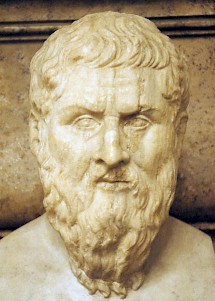
As we have seen, the traditional image of pedagogical pederasty is simply mistaken, so what is its origin? The answer is the philosophy of the Athenian Plato. He has painted a very remarkable picture of his teacher Socrates, who is shown - in Plato's own words - as boy crazy. When Socrates was in the company of beautiful boys, he lost his senses. Some sort of mania (divine madness) took possession of him and he was almost unable to resist it. He often complained about the fact that he was helpless towards adolescents, and said that he could only cope with the situation by asking difficult questions to these beautiful boys and teaching them philosophy. So, according to Plato, Socrates sublimated his passion.
This is not just Plato's portrayal of his admired teacher. That Socrates was well-known for this attitude is more or less confirmed by another student, the mercenary leader and author Xenophon (c.430-c.354). He informs us that his master, when challenged by the presence of a good looking adolescent, remained capable of self-control, but took some measures. He did not allow the boy to embrace him, comparing his kisses to spider's bites. Sexuality and other physical contact between teacher and student were simply unacceptable.
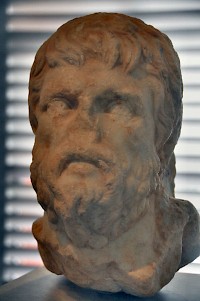
This is a bolder portrayal than that of Plato (whose Socrates sometimes yielded to the temptation), but both writers agree that their master believed that the contacts between erastes and eromenos could not only be aimed at sexual love, but also at obtaining moral wisdom and strength. A rather remarkable educational ideal.
In this context, Socrates/Plato introduces an influential metaphor. Procreation, he says, can be earthly and spiritual, just like love. After all, love can be physical -aimed at the beautiful body of a boy- and spiritual, which he believes is on a higher level. This last type of love can be described as longing for something good and possessing it. The true erastes will prefer the beauty of the soul above that of the body. Instead of a material/earthly parenthood (the procreation of children) he prefers the spiritual type, which is the creation of virtue and knowledge. According to Socrates/Plato, the eromenos' understanding grows and in the end, he will be able to see a beauty that is above all earthly standards, compared to which even the most beautiful boy is nothing. In other words, by spiritually loving a beautiful beloved, the lover reaches an understanding of absolute beauty. Philosophy is, therefore, an erotical enterprise.
It should be added that for Plato, the only type of real love is the love between two men, and he has dedicated two of his dialogues to that subject: the Symposium and the Phaedrus. After all, homo-erotic love is related to education and gaining knowledge, and this makes it superior to other types of love.
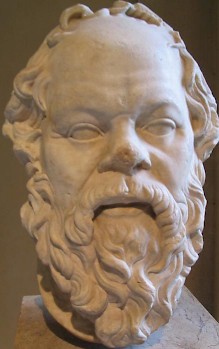
In 399 BCE, Socrates was executed on a charge of corrupting the Athenian youth. This is a bit mysterious, because there was no Athenian law that said that people who taught bad ideas to young people ought to be killed. Socrates cannot have been guilty of breaking any written law. However, his fellow-citizens have interpreted this "corruption of the youth" as a sexual corruption: they took literally Socrates' metaphor that he loved boys, and this was indeed breaking the old law of 450 (above) that forbade young citizens to sell themselves. Correctly or not, Socrates was held responsible for inducing boys to prostitution.
Plato has tried to take away the blame from Socrates by pointing at his sincere and spiritual aims. In another context, he presents his master as saying that men who play the passive role are guilty of despicable and rampant behavior. After all, Socrates/Plato says, these men behave like women and are slaves of their passions. In the dialogue called Gorgias, Socrates declares that he is against all kinds of excessive sexual acts, and in Plato's main work, The State, Socrates even rejects all kinds of physical contact as some sort of unbridled behavior: the good lover treats his beloved one as a father treats his son.
It cannot be said whether Plato's description of Socrates' ideas and behavior correspond to what Socrates really said and did. What we do know, however, is that it was at odds with common behavior in ancient Athens.